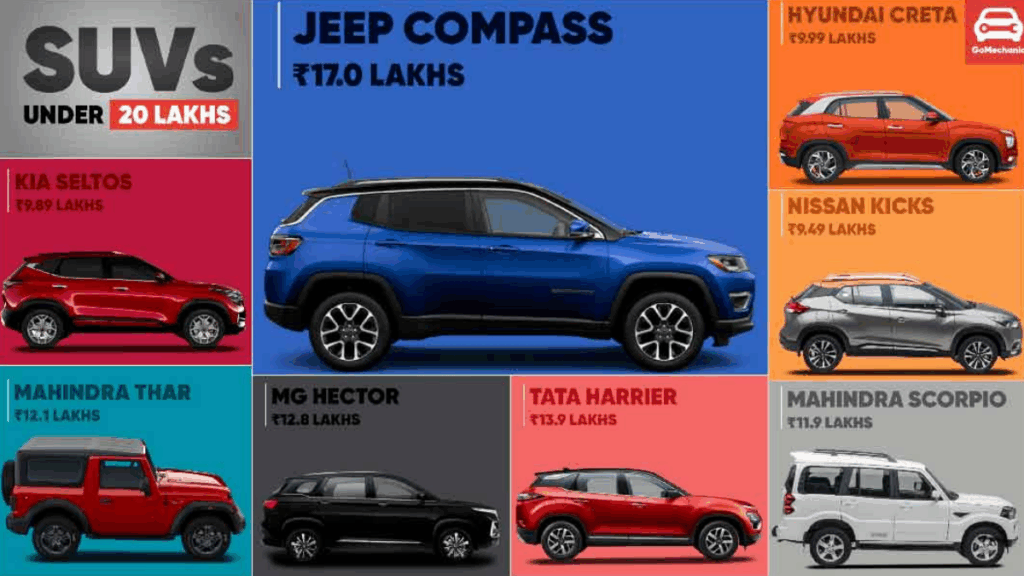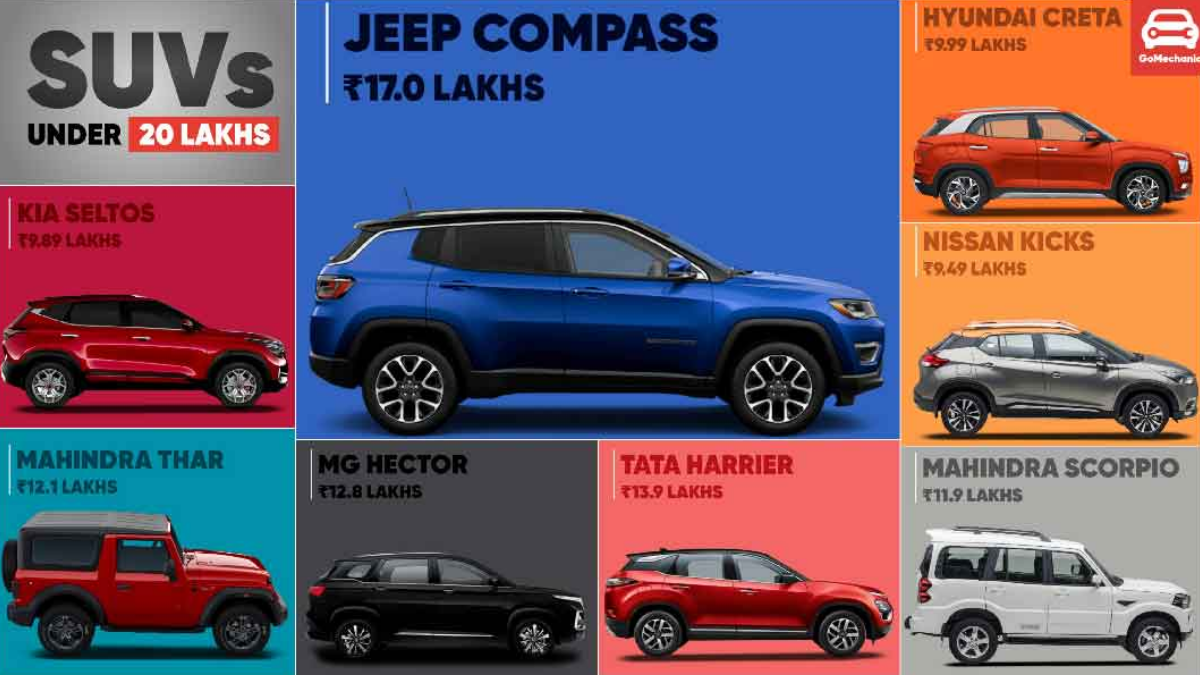India’s SUV market continues to boom in 2025. Buyers want a single car that handles weekday commutes, out of town trips, and family duties without breaking the bank. The sweet spot for many shoppers is the under ₹20 lakh bracket where you can now get modern safety tech, panoramic sunroofs, connected screens, and powertrains that balance performance with efficiency. Below is a clear, model wise guide that sticks to what matters in real life. Each entry includes the essence of the vehicle, why it works, who it suits best, and the price band that keeps it in play for the mid range buyer.

How We Picked
- Strong sales and service footprint for easier ownership
- Balanced feature set that covers safety, comfort, and connectivity
- Multiple powertrain choices so you can pick efficiency or punch
- Solid value at base and mid variants, not only at the top trim
Quick Summary
Item |
Details |
|---|---|
Focus |
Best value SUVs under ₹20 lakh in 2025 for families and daily commuters |
Standout Picks |
Hyundai Creta for all round balance, Tata Harrier for safety and road presence, Maruti Grand Vitara for efficiency |
Price Window |
Roughly ₹8 lakh to ₹20 lakh ex showroom depending on model and variant |
Fuel Options |
Petrol, turbo petrol, diesel, strong hybrid depending on model |
Buyer Tip |
Shortlist three models that fit your usage and test drive all three on the same day |
Official Sites |
Hyundai, Kia, Tata, Maruti Suzuki, Mahindra, Honda, Toyota |
Hyundai Creta
Why it is popular: Creta has long set the template for the segment. The 2025 facelift sharpened the look and added high demand features like a panoramic sunroof, a 10.25 inch touchscreen, and available ADAS on select variants.
What stands out: Cabin practicality, refined powertrains, wide variant spread, and a user friendly interface. The ride quality suits both city and highway.
Who should buy: Families that want a no drama all rounder with strong resale and a wide dealer network.
Indicative starting price: About ₹11 lakh ex showroom depending on location and offers.
Kia Seltos
Why it is compelling: Seltos is the Creta’s tech forward cousin. It scores with a tasteful design inside and out, along with feature hits like ventilated front seats, a digital cluster, and a 360 degree camera on higher variants.
Powertrain mix: Smooth 1.5 petrol and punchy turbo petrol or diesel options depending on variant and city availability.
Who should buy: Buyers who want crisp design and a little more tech flair without losing daily comfort.
Indicative starting price: About ₹11.5 lakh ex showroom.
Tata Harrier
Why it is different: Harrier brings big SUV presence into the sub ₹20 lakh conversation at entry variants. The 2025 model looks muscular and carries a strong safety reputation with a 5 star Global NCAP rating.
What stands out: 2.0 litre Kryotec diesel torque, planted highway manners, and a premium cabin ambience on higher trims.
Who should buy: Highway heavy users who value safety, road presence, and a relaxed long distance ride.
Indicative starting price: Around ₹15 lakh ex showroom for entry variants that dip under the ₹20 lakh ceiling.
Maruti Suzuki Grand Vitara
Why it is smart: Strong hybrid tech makes the Grand Vitara an efficiency champion. Claimed mileage can touch the high twenties kmpl in the right cycle, and real world savings add up for city commuters.
What stands out: Option of all wheel drive on select trims, a panoramic sunroof, and a comfortable cabin that prioritizes economy without feeling sparse.
Who should buy: Daily city runners and Uber long commuters who want the lowest fuel bills with family friendly space.
Indicative starting price: Around ₹10.8 lakh ex showroom for base trims.
Mahindra XUV 3XO
What it is: The next generation of the XUV300 with a bold design update. It blends a compact footprint with a feature packed interior that includes a dual screen layout and premium audio on higher trims.
Why it works: The 1.2 litre turbo petrol is eager in city traffic and the cabin tech will appeal to younger buyers.
Who should buy: First time SUV buyers and urban users who want an affordable entry yet premium feel inside.
Indicative starting price: Around ₹9 lakh ex showroom.
Honda Elevate
Why it matters: Elevate leans on Honda’s reliability and a refined 1.5 litre petrol that is easy to live with. The cabin is airy and visibility is excellent which reduces fatigue on long drives.
What stands out: Practical ergonomics, a spacious second row, and straightforward ownership backed by a wide Honda network.
Who should buy: Families that value simplicity, long term reliability, and a comfortable driving position.
Indicative starting price: About ₹11 lakh ex showroom.
Toyota Urban Cruiser Taisor
What it is: A compact, city friendly SUV built on the Maruti Fronx platform with Toyota tuning and design cues.
Why it works: The lively 1.0 litre turbo petrol keeps the Taisor fun in traffic while the design feels sporty and youthful. It is easy to park, easy to run, and respects your budget.
Who should buy: Urban users who want style, performance for the size, and low running costs.
Indicative starting price: Around ₹8 lakh ex showroom.
Which One Should You Buy
- Mostly city with weekend trips: Hyundai Creta or Kia Seltos
- Highway touring and safety focus: Tata Harrier
- Fuel efficiency above all: Maruti Grand Vitara strong hybrid
- First SUV with tight city parking: Mahindra XUV 3XO or Toyota Taisor
- Comfort and reliability: Honda Elevate
Shortlist two or three based on your driving pattern. Drive them back to back on the same route. Check second row comfort with your family on board and try a bad road patch to judge ride quality.
Frequently Asked Questions
1. Are these prices on road or ex showroom
Figures listed here are indicative ex showroom starting prices. On road prices vary by city due to taxes, insurance, handling, and optional accessories.
2. Petrol, diesel, or hybrid. Which should I pick
Choose petrol for lower upfront cost and smoother city use. Diesel suits high mileage highway users who want torque and longer range. Hybrid is ideal for heavy city traffic where fuel savings are significant over time.
3. Is ADAS worth paying for under ₹20 lakh
If you drive on highways often, features like adaptive cruise and lane centering can reduce fatigue. In cities, autonomous emergency braking and blind spot warnings add a safety layer. Evaluate how many ADAS functions are included at your target price point.
4. How do I compare running costs across these SUVs
Estimate monthly distance, local fuel prices, expected mileage, and service intervals. Strong hybrids usually lower monthly fuel bills. Diesels cost more upfront but can pay back with higher monthly distances.
5. What is the single most important test during a test drive
Ride quality and second row comfort. If your family is not comfortable on poor tarmac and speed breakers, features will not compensate. Also check visibility, steering effort in tight turns, and braking feel.
Official Sites:
Hyundai: https://www.hyundai.com/in/en
Kia: https://www.kia.com/in
Tata: https://cars.tatamotors.com
Maruti Suzuki: https://www.marutisuzuki.com
Mahindra: https://auto.mahindra.com
Honda: https://www.hondacarindia.com
Toyota: https://www.toyotabharat.com
For More Information Click HERE
